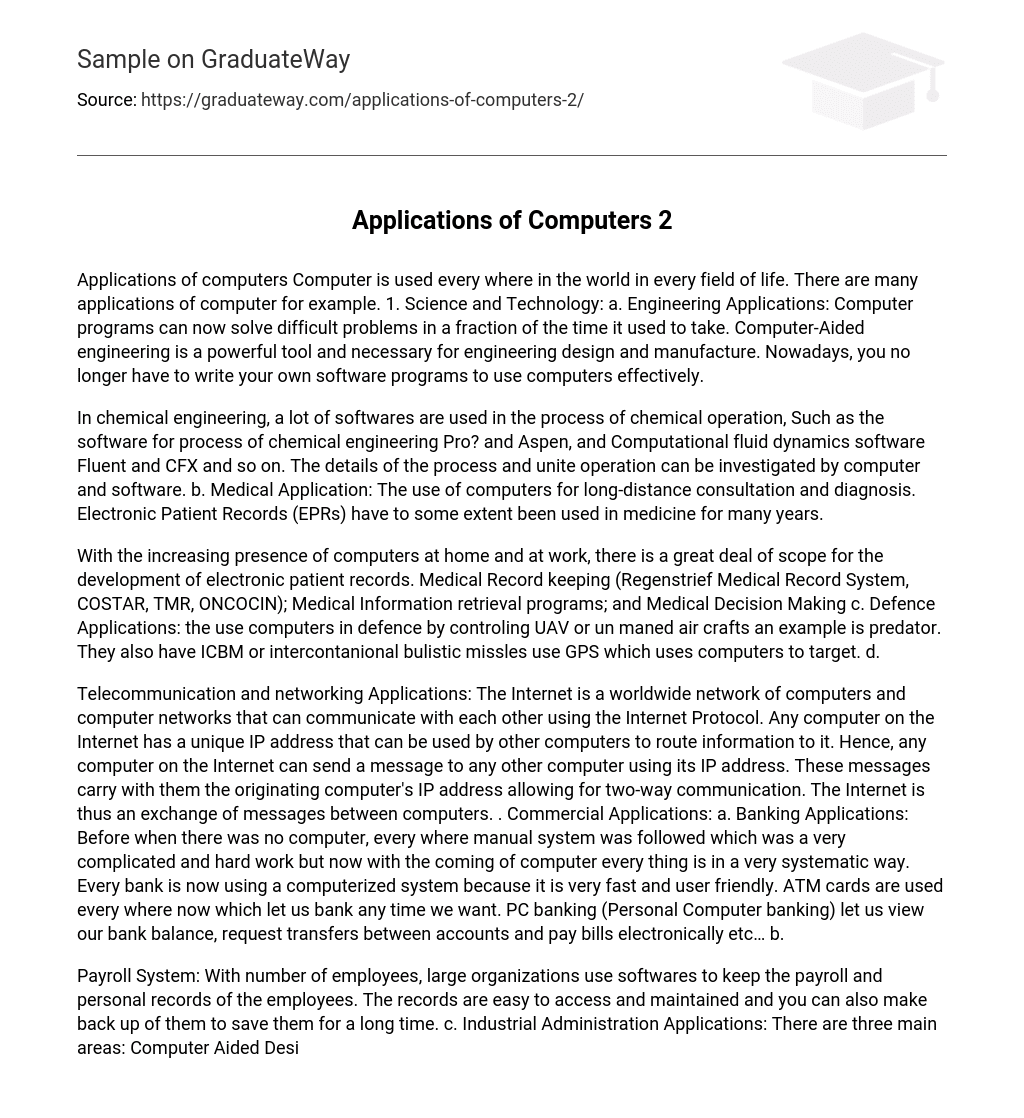Applications of computers Computer is used every where in the world in every field of life. There are many applications of computer for example. 1. Science and Technology: a. Engineering Applications: Computer programs can now solve difficult problems in a fraction of the time it used to take. Computer-Aided engineering is a powerful tool and necessary for engineering design and manufacture. Nowadays, you no longer have to write your own software programs to use computers effectively.
In chemical engineering, a lot of softwares are used in the process of chemical operation, Such as the software for process of chemical engineering Pro? and Aspen, and Computational fluid dynamics software Fluent and CFX and so on. The details of the process and unite operation can be investigated by computer and software. b. Medical Application: The use of computers for long-distance consultation and diagnosis. Electronic Patient Records (EPRs) have to some extent been used in medicine for many years.
With the increasing presence of computers at home and at work, there is a great deal of scope for the development of electronic patient records. Medical Record keeping (Regenstrief Medical Record System, COSTAR, TMR, ONCOCIN); Medical Information retrieval programs; and Medical Decision Making c. Defence Applications: the use computers in defence by controling UAV or un maned air crafts an example is predator. They also have ICBM or intercontanional bulistic missles use GPS which uses computers to target. d.
Telecommunication and networking Applications: The Internet is a worldwide network of computers and computer networks that can communicate with each other using the Internet Protocol. Any computer on the Internet has a unique IP address that can be used by other computers to route information to it. Hence, any computer on the Internet can send a message to any other computer using its IP address. These messages carry with them the originating computer’s IP address allowing for two-way communication. The Internet is thus an exchange of messages between computers. . Commercial Applications: a. Banking Applications: Before when there was no computer, every where manual system was followed which was a very complicated and hard work but now with the coming of computer every thing is in a very systematic way. Every bank is now using a computerized system because it is very fast and user friendly. ATM cards are used every where now which let us bank any time we want. PC banking (Personal Computer banking) let us view our bank balance, request transfers between accounts and pay bills electronically etc… b.
Payroll System: With number of employees, large organizations use softwares to keep the payroll and personal records of the employees. The records are easy to access and maintained and you can also make back up of them to save them for a long time. c. Industrial Administration Applications: There are three main areas: Computer Aided Design (CAD), Computer Aided Manufacture (CAM) and Robotics. In many industries the traditional drawing board is almost a relic. d. Business Applications: Computers have become a requirement in the business industry.
Computers easily complete duties that are tedious and timely for humans. The business uses of computers are extensive. Although many of the computer duties are not irreplaceable, business has become dependent on their accuracy and timeliness. 3. Educational Applications: a. Computerised Assisted Learning [CAL]: Computer-assisted learning is to convey a vast amount of information in a very short period of time. It is a powerful method of reinforcing concepts and topics first introduced to you through your textbook, and discussion in the classroom.
Computer-assessed learning enables you in a powerful way to comprehend complex concepts. b. Computer Aided Instruction [CAI]: diverse and rapidly expanding spectrum of computer technologies that assist the teaching and learning process. CAI is also known as computer-assisted instruction. Examples of CAI applications include guided drill and practice exercises, computer visualization of complex objects, and computer-facilitated communication between students and teachers.





